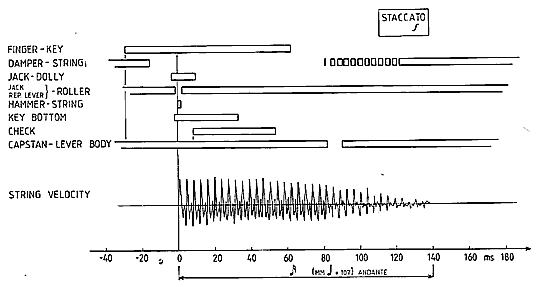
[<- Previous] [Contents of this lecture] [Next ->]
We measured the timing in the action electrically by a network of "micro-switches," integrated with the action. These switches consisted of copper foils and thin copper wires glued and sewn to the contact surfaces. During a blow, the different switches turned off and on as the parts moved, and a stepwise signal was generated at the output of the network.
In order to obtain blows which could be repeated with a high degree of reproducibility in the timing experiments, we also had to develop "a mechanical pianist." It turned out that for this particular purpose a long pendulum was ideal as a substitute for the player.

Fig. 3. Overview timing diagram of the grand action for a "staccato-touch," forte, C4. The string vibrations are included for reference. Note the time scale (20 ms/div), and the comparison with the duration of the sixteenth-note in andante (M.M. = 107 beats/min).
A typical example of a timing diagram for a "staccato-note" - a short note played with the finger striking the key from some distance above the key - is shown in Fig. 3. First of all, it can be noted that the processes which take place in the action are very fast. While the duration of the rather short note in this example is about a 1/10th of a second (100 ms), the contact between the hammer and string lasts only a few thousandths of a second (1/1000 s = 1 millisecond = 1 ms). The contact with the string is preceded by a long history, during which different parts are engaged in turn, but it is only during these few milliseconds energy is transferred into the string.
Listing the most important steps chronologically, starting with the player's finger on the key, we see that the damper is lifted off the string plenty of time (15 ms) before the hammer strikes the string. Much later, only a few milliseconds before hammer-string contact, the tail end of the jack reaches the escapement dolly, and the top of the jack starts to withdraw from the hammer roller. Just before (less than 1 ms) the impact on the string, the jack loses contact with the roller, and the hammer swings freely during the final part of its travel. At about the same moment the key happens to reach its bottom position.
The height of this chain of events, the hammer-string contact, occupies only about 2 ms. Almost immediately after the hammer-string contact has ceased, the hammer returns, first making contact with the repetition lever before it is checked. If the key were held down after the stroke, the action would remain in this state while the note decayed undisturbed. In this example, however, the key is immediately released ("staccato"), and the parts of the action revert to their initial positions. The note is terminated when the damper falls down on the string approximately 80 ms after hammer-string contact and brings the string to rest after some bouncing.
[<- Previous] [Top] [Contents of this lecture] [Next ->]
This lecture is one of Five lectures on the Acoustics of the piano
© 1990 Royal Swedish Academy of Music